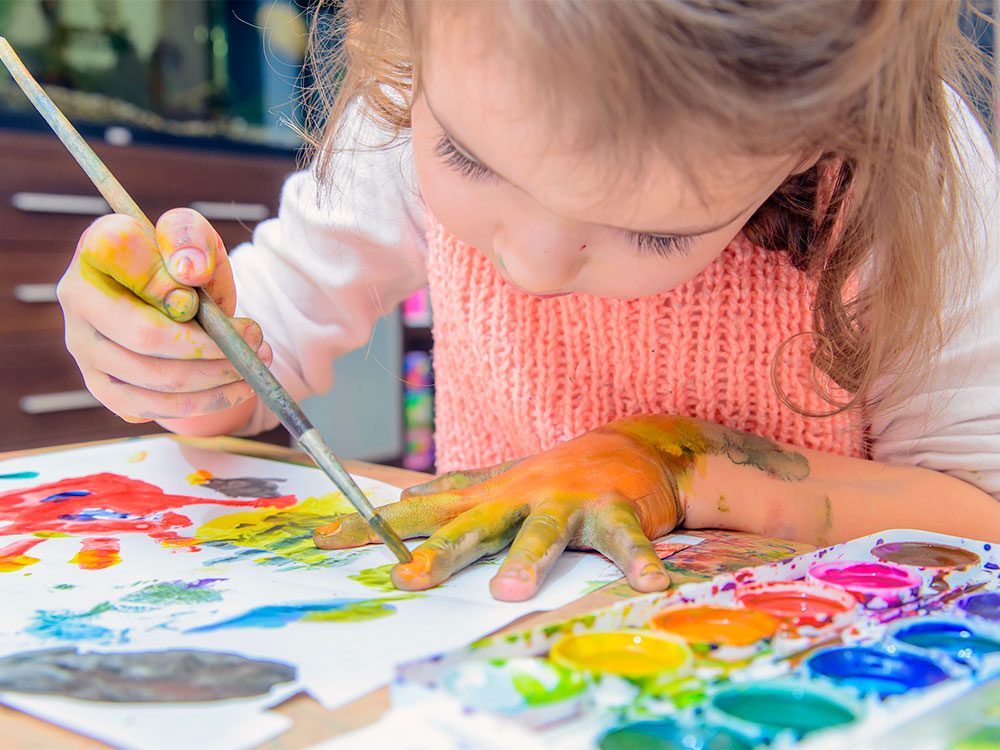
When Leonardo da Vinci was a child, he dropped rocks in shallow creeks to see how the water swirled. The larger the rock, the bigger the swirl. Leonardo studied the movement of the water and was forever fascinated by how various objects could maneuver it. Many of his paintings alluded to this enchantment of his. An example of this is that we know from reviewing his notebooks that the locks of hair in his paintings represented the ripples in the water he played with as a child. Leonardo also used this intrigue to help create many of his inventions, including designs for a water-powered alarm clock and scuba gear. In his youth, da Vinci could use his imagination, which formed the foundational building blocks for the rest of his life.
The goal is not for your child to become Leonardo da Vinci. It is, however, to learn from the examples of his life to help bring out their natural creativity. A striking example of this is that da Vinci was free to explore his imagination without parental intervention. We as parents should resist the urge to interject ourselves in our children’s creative play regularly and instead allow them to do so independently. This does not suggest that parents should never participate in creative play with their children, which is far from it. It suggests that children need time to play both independently and with their peers without a parent commandeering their thoughts and movements. Playtime is a serious business for a young child. It is one of the most serious things a child will do. It is consequential to them at the moment and crucial for their overall creative development.
Judith Rich Harris was a prominent psychologist who specialized in the field of child development. Her most famous book, The Nurture Assumption, laid out the vast amount of research and evidence that children’s personalities are uniquely their own and that we, as parents, cannot willfully designate personalities to them. Instead, it is a combination of genetics and environment that help to mold a child’s personality. An easy way to prove this theory is to try to swap out your children’s personalities with one another. You will quickly see that it cannot be done. So, with having this information at our fingertips, how do we cultivate creativity in our children? The answer is to establish a creative environment that allows and encourages imaginations to reach their full potential.
Many modern toys serve a specific function. A battery-operated toy dog that barks on command or a plastic robot with wheels make great, entertaining toys. However, they limit the various ways in which a child can interact with them. There is the shared parental experience in which you get a nice gift for your young child, but they seem only to want to play with the big box it came in. This is their imagination at work, and this type of play should be encouraged. Cardboard boxes, spatulas, tape measurers, wooden blocks, or any other seemingly mundane object can be turned into something extraordinary with a child’s imagination. The only catch is that they must be allowed the opportunity for this type of play. Getting the newest toy for your child is great; just be sure to allow for play that propels them into creativity. Does the toy tell them how to play with it? Or is the toy built to rely on the child’s imagination?
A straightforward way of thinking about fostering imagination within your children is to think of it as shepherding. The role of a shepherd is to protect, guide, and care for specific needs. When you take a hands-off approach that allows time for children to play either individually or with their peers, their imagination will no longer hold the constraints that they would have otherwise forgone. The gift of a child exploring imaginative play by themselves means they will learn how to better problem solve. In addition, they gain a healthy level of independence, which will, in turn, build self-confidence. When they engage in creative play with their peers, they construct strong characteristics of teamwork, communication skills, and trust. Play with your children. Be creative with your children. It also allows them regular opportunities to set their own rules and limits regarding imaginative play.
Leonardo da Vinci’s father, Ser Piero da Vinci, first noticed his son’s artistic ability. So, instead of disregarding his son’s talents and interests, Piero shepherded them and helped Leonardo foster his skills in an appropriate setting. Piero did not demand that Leonardo become something he could not be but rather used his resources to get him in as a student in an artist workshop. Each of our personalities is our own, and we all, including our children, should be able to lean into this.
Below are links to Oregon locations that can help foster your child’s own creativity:
https://portlandartmuseum.org/

Alex is a devoted husband and father born and raised in Portland, Oregon. He is a professional artist, author, and advisor for both Yale and Harvard University’s arts departments. His books, ‘Selling Leonardo: The Art World’s Greatest Scandal’ and ‘Holy Ghost: Decoding Leonardo da Vinci’s Final Painting’ are available wherever books are sold.
One thought on “How To Encourage And Shepherd Creativity In Your Child”
Comments are closed.

Fantastic Information for new parents! A very thought provoking piece.